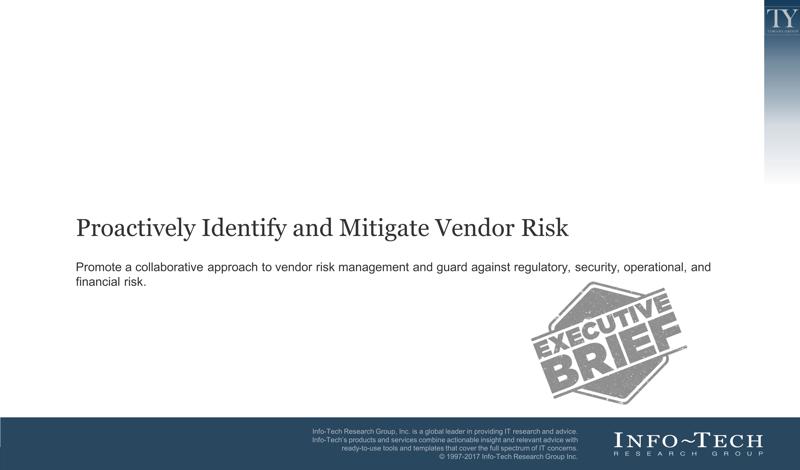
Proactively Identify and Mitigate Vendor Risk
- IT priorities are focused on daily tasks, pushing risk management to secondary importance and diverging from a proactive environment.
- IT leaders are relying on an increasing number of third-party technology vendors and outsourcing key functions to meet the rapid pace of change within IT.
- Risk levels can fluctuate over the course of the partnership, requiring manual process checks and/or automated solutions.
Our Advice
Critical Insight
- Every IT vendor carries risks that have business implications. These legal, financial, security, and operational risks could inhibit business continuity and IT can’t wait until an issue arises to act.
- Making intelligent decisions about risks without knowing what their financial impact will be is difficult. Risk impact must be quantified.
- You don’t know what you don’t know, and what you don’t know, can hurt you. To find hidden risks, you must use a structured risk identification method.
Impact and Result
- A thorough risk assessment in the selection phase is your first line of defense. If you follow the principles of vendor risk management, you can mitigate collateral losses following an adverse event.
- Make a conscious decision whether to accept the risk based on time, priority, and impact. Spend the required time to correctly identify and enact defined vendor management processes that determine spend categories and appropriately evaluate potential and preferred suppliers. Ensure you accurately assess the partnership potential.
- Take a proactive stance against IT threats and vulnerabilities by identifying and assessing IT’s most significant risks before they happen.
Proactively Identify and Mitigate Vendor Risk Research & Tools
Start here – read the Executive Brief
Read our concise Executive Brief to find out how to create a vendor risk management program that minimizes your organization’s vulnerability and mitigates adverse scenarios.Besides the small introduction, subscribers and consulting clients within this management domain have access to:
- Proactively Identify and Mitigate Vendor Risk – Phases 1-3
1. Review vendor risk fundamentals and establish governance
Review IT vendor risk fundamentals and establish a risk governance framework.
- Proactively Identify and Mitigate Vendor Risk – Phase 1: Review Vendor Risk Fundamentals and Establish Governance
- Vendor Risk Management Maturity Assessment Tool
- Vendor Risk Management Program Manual
- Risk Event Action Plan
2. Assess vendor risk and define your response strategy
Categorize, prioritize, and assess your vendor risks. Follow up with creating effective response strategies.
- Proactively Identify and Mitigate Vendor Risk – Phase 2: Assess Vendor Risk and Define Your Response Strategy
- Vendor Classification Model Tool
- Vendor Risk Profile and Assessment Tool
- Risk Costing Tool
- Risk Register Tool
3. Monitor, communicate, and improve IT vendor risk process
Assign accountability and responsibilities to formalize ongoing risk monitoring. Communicate your findings to management and share the plan moving forward.
- Proactively Identify and Mitigate Vendor Risk – Phase 3: Monitor, Communicate, and Improve IT Vendor Risk Process
- Risk Report
Workshop: Proactively Identify and Mitigate Vendor Risk
Workshops offer an easy way to accelerate your project. If you are unable to do the project yourself, and a Guided Implementation isn't enough, we offer low-cost delivery of our project workshops. We take you through every phase of your project and ensure that you have a roadmap in place to complete your project successfully.
1 Prepare for the Workshop
The Purpose
To prepare the team for the workshop.
Key Benefits Achieved
Avoids delays and interruptions once the workshop is in progress.
Activities
1.1 Send workshop agenda to all participants.
1.2 Prepare list of vendors and review any contracts provided by them.
1.3 Review current risk management process.
Outputs
All necessary participants assembled
List of vendors and vendor contracts
Understanding of current risk management process
2 Review Vendor Risk Fundamentals and Establish Governance
The Purpose
Review IT vendor risk fundamentals.
Assess current maturity and set risk management program goals.
Engage stakeholders and establish a risk governance framework.
Key Benefits Achieved
Understanding of organizational risk culture and the corresponding risk threshold.
Obstacles to effective IT risk management identified.
Attainable goals to increase maturity established.
Understanding of the gap to achieve vendor risk readiness.
Activities
2.1 Brainstorm vendor-related risks.
2.2 Assess current program maturity.
2.3 Identify obstacles and pain points.
2.4 Develop risk management goals.
2.5 Develop key risk indicators (KRIs) and escalation protocols.
2.6 Gain stakeholders’ perspective.
Outputs
Vendor risk management maturity assessment
Goals for vendor risk management
Stakeholders’ opinions
3 Assess Vendor Risk and Define Your Response Strategy
The Purpose
Categorize vendors.
Prioritize assessed risks.
Key Benefits Achieved
Risk events prioritized according to risk severity – as defined by the business.
Activities
3.1 Categorize vendors.
3.2 Map vendor infrastructure.
3.3 Prioritize vendors.
3.4 Identify risk contributing factors.
3.5 Assess risk exposure.
3.6 Calculate expected cost.
3.7 Identify risk events.
3.8 Input risks into the Risk Register Tool.
Outputs
Vendors classified and prioritized
Vendor risk exposure
Expected cost calculation
4 Assess Vendor Risk and Define Your Response Strategy (continued)
The Purpose
Determine risk threshold and contract clause relating to risk prevention.
Identify and assess risk response actions.
Key Benefits Achieved
Thorough analysis has been conducted on the value and effectiveness of risk responses for high-severity risk events.
Risk response strategies have been identified for all key risks.
Authoritative risk response recommendations can be made to senior leadership.
Activities
4.1 Determine the threshold for (un)acceptable risk.
4.2 Match elements of the contract to related vendor risks.
4.3 Identify and assess risk responses.
Outputs
Thresholds for (un)acceptable risk
Risk responses
5 Monitor, Communicate, and Improve IT Vendor Risk Process
The Purpose
Communicate top risks to management.
Assign accountabilities and responsibilities for risk management process.
Establish monitoring schedule.
Key Benefits Achieved
Risk monitoring responsibilities are established.
Transparent accountabilities and established ongoing improvement of the vendor risk management program.
Activities
5.1 Create a stakeholder map.
5.2 Complete RACI chart.
5.3 Establish the reporting schedule.
5.4 Finalize the vendor risk management program.
Outputs
Stakeholder map
Assigned accountability for risk management
Established monitoring schedule
Risk report
Vendor Risk Management Program Manual